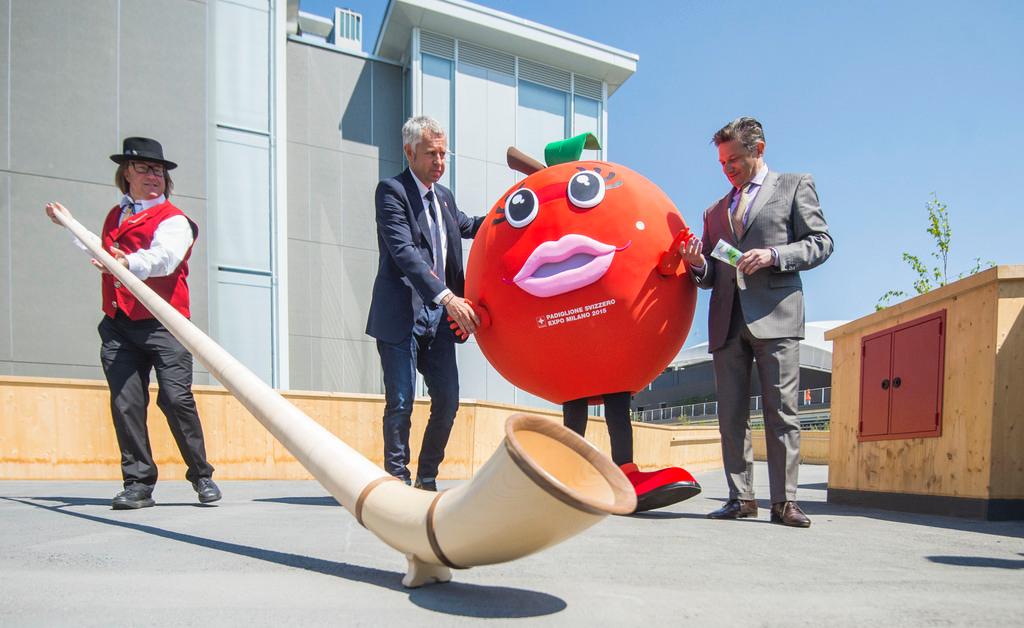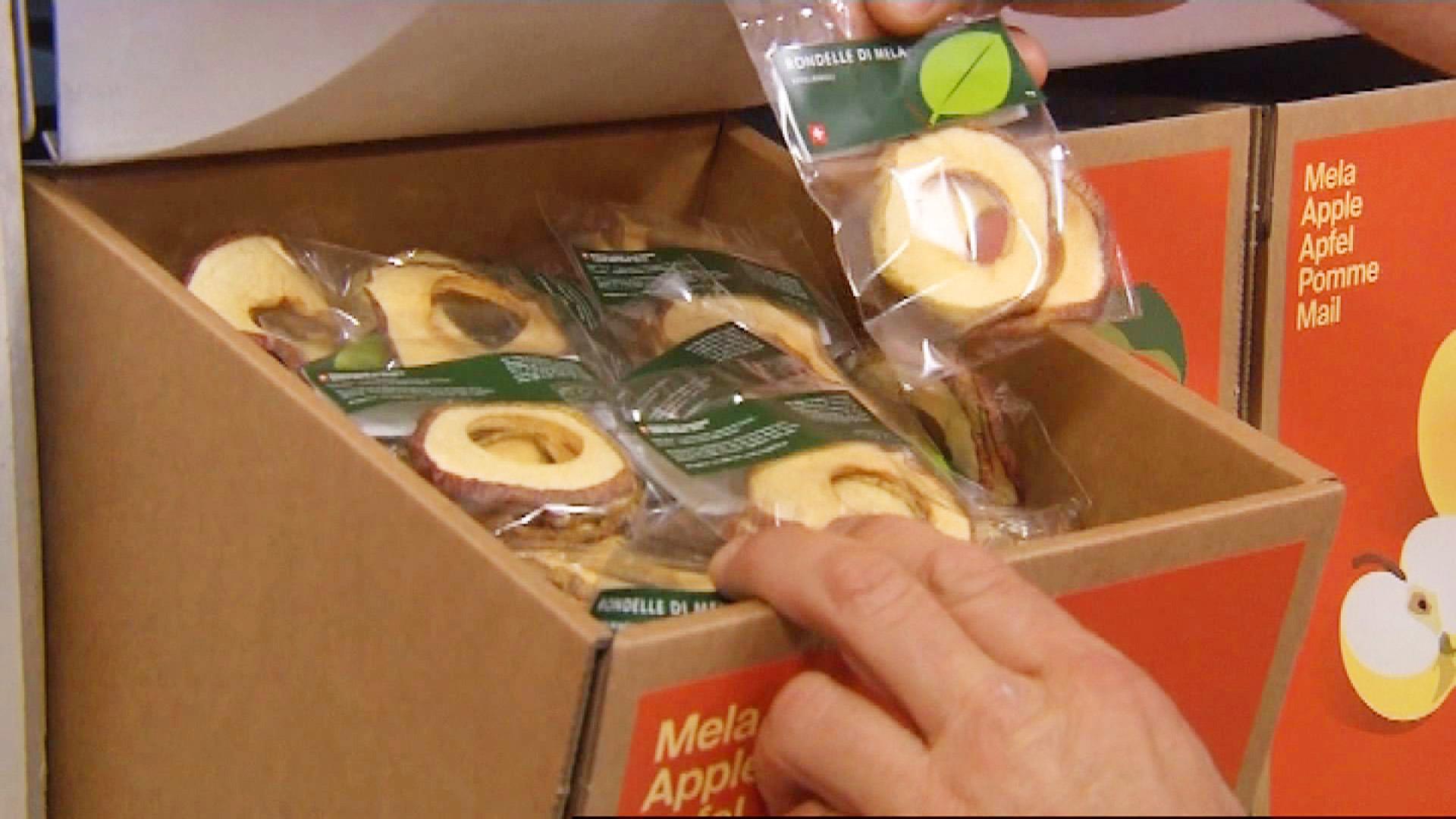What visitors to the Swiss pavilion take with them
The Swiss pavilion at the Expo 2015 in Milan is focusing on the core theme of food resources rather than flashy PR. Is it working? Two weeks after the Expo opened, swissinfo.ch hears the reactions of visitors to the house of the “Swiss ConfooderationExternal link”.
“It embodies the very principle of the Expo,” said Marco Gallocchio from Padua enthusiastically as he got out of the pavilion’s lift, cup of water in hand. “Here we can really get our hands on responsible consumption.”
Sarah from Fehraltorf just outside Zurich finds the idea “cool – it exists for as long as it exists”. She said it was about “not filling your pockets – you think of the people coming after you”.
Barbara from Rapperswil, northeastern Switzerland, is a bit disappointed by the architecture, “but I think the idea – that there are things which you can take with you and which at some point will run out – is great”.
“A very original idea of sustainability – and of the resources which are dwindling every day. A really central issue for the world today,” said Roberto Penna from Milan.
“It shows that everything is finite,” concluded Atanas, an elderly man from Berlin. He wasn’t, however, overly impressed by the staff, who, in his opinion, were rather disorganised.
That might be because they are still working on getting everything running smoothly and because the crowds visiting the Swiss pavilion have already been large.
As with previous world Expos – Aichi, Japan, in 2005 and Shanghai, China, in 2010 – relatively long queues have been lining up in front of the Swiss pavilion. This is despite the focus not being on clichés such as mountains, cable cars and innovations.
Positive feedback
“Most of the feedback has been positive. At Expos there’s always a sort of ranking of the most attractive pavilions, and we’re up near the top because our pavilion contributes to the theme of the Expo: nutrition and sustainability,” Andrea Arcidiacono, Swiss pavilion spokesman, told swissinfo.ch.
“Is there enough for everybody?” This question is emblazoned across the four 15-metre towers of the pavilion. The walls of the towers are stocked with foodExternal link, the levels of which can be seen from outside.
A lift takes visitors to the fourth floor of the first tower, where they can take small packets of coffee (Switzerland has been a major exporter of coffee since the 1930s). In the second tower are dried apple rings (delivered by small producers from eastern Switzerland). In the third, small cartons of salt from the Swiss Alps, and in the fourth, thirst can be quenched with local spring water (cups are available if you want to take it with you).
The principle is simple: the floor of the four towers is a platform which sinks depending how much is taken – allowing visitors to experience consumption directly. It can already be seen that apple rings and water are more popular than salt and coffee.
“The platform will only go down if a level is empty in all four towers,” Arcidiacono explained. “That means that in two or three weeks visitors might not be able to find any more apple rings but perhaps coffee and salt.” They will then have to wait until all the coffee and salt are gone on the fourth floor before the platform drops a level – and visitors can have access to the next floor of goodies.
‘Social experiment’
He says it is therefore a “dynamic pavilion, a sort of social experiment”. But if, as expected, three million visitors come and help themselves, there won’t be enough for everybody. There are 2.5 million coffee bags, two million salt cartons and even fewer portions of apple rings and water cups.
But the undersupply is part of the concept, he explained. “When a tower runs out, it will stay empty. And we will communicate this emptiness, a message in itself: ‘the first visitors took so much that there wasn’t enough for the others’. That’s also a picture of society today, where many people have too much and others not enough.”
So is the idea – that visitors should act with consideration – catching on? “There was one visitor who took a whole box of apple rings,” Arcidiacono replies with an anecdote. “When he got out of the lift, other people looked at him and questioned him. He was embarrassed and brought it back.”
Federica, an 18-year-old from Lecco, 50km north of Milan, told swissinfo.ch she had taken just an empty cup. “It’s all about the principle of not being selfish but thinking of those around you.”
Travelling equally light are Wakaba Nagakura and her mother from Yokohama in Japan. “It’s important not to be too selfish, taking things only for you, but sharing them,” she said.
Luca Larossa from Stuttgart in Germany had consciously restrained himself. “I took a bit of water. I just left the other things, which weren’t so important for me,” he said.
Private funding
A woman from Locarno and a man from Monte Carasso, both in Italian-speaking Switzerland, took only a little water and some coffee.
The fact that the coffee is provided by Swiss food and drink giant Nestlé – which has its own exhibition in a nearby pavilion – attracted criticism in the media but doesn’t seem to bother anyone here.
“Nestlé is a part of Swiss history,” said Arcidiacono, adding that the Swiss pavilion was based on a public-private partnership. “Parliament forces us to find external funds. And the large multinationals have realised that companies have a social responsibility.”
Wiebke from Germany, who gets out of the lift with a group of colleagues, said she wasn’t aware that so much coffee or so many apples were marketed in Switzerland.
Even though the Swiss pavilion isn’t showy – unlike other pavilions – it still scores well with visitors.
“It’s lean, not flashy. Very purist,” reckoned 20-year-old Sandro from canton Zurich. “Switzerland isn’t doing any advertising – it’s concentrating on the issue. It’ll be exciting to see which tower is emptied first.”
Recyclable
“Many countries are going big on technology – videos – and want to showcase themselves,” said Giulio Montecchio, a student from Padua. A teacher from Brescia agreed, adding that “others were focusing more on tourism”.
Arcidiacono stressed that the topic of Swiss food had certainly been addressed in the pavilion, with a restaurant, snack stall, raclette and chocolate workshops and countless other events and activities on the issues of solidarity and the economical use of resources.
But what will become of the buzzword sustainability at the end of the Expo? “The plan is for the towers to return to Switzerland and be used as urban greenhouses,” Arcidiacono said. “A few cities and a foundation have expressed an interest.”
He added that three-quarters of the materials were recyclable, including the concrete, which like the food and drink in the towers had been made in Switzerland.
The Milan world fair takes place from May 1 to October 31, 2015. Twenty million visitors are expected, a quarter of whom coming from abroad. Sixty countries have built pavilions.
The theme of Expo 2015, “Feeding the planet – energy for life”, will tackle the issue of feeding the global population while respecting the earth and its resources.
The name of Switzerland’s pavilion, “Confooderatio Helvetica”, is a pun on the official Latin name of the Swiss federation, “Confoederatio Helvetica”, source of the “.ch” in Swiss internet addresses and CH on the back of cars.
The Swiss government has approved a budget of CHF23.1 million ($25 million) for the pavilion, CHF8 million of which is to be funded by sponsors from the public and private sectors – cantons, cities and businesses.
“Confooderatio Helvetica” is the third-largest pavilion after the Italian and German ones.
Swiss participation in Expo Milano 2015 is the responsibility of Presence Switzerland, the foreign ministry organisation that promotes the image of Switzerland abroad.
(Translated from German by Thomas Stephens)

In compliance with the JTI standards
More: SWI swissinfo.ch certified by the Journalism Trust Initiative





You can find an overview of ongoing debates with our journalists here. Please join us!
If you want to start a conversation about a topic raised in this article or want to report factual errors, email us at english@swissinfo.ch.